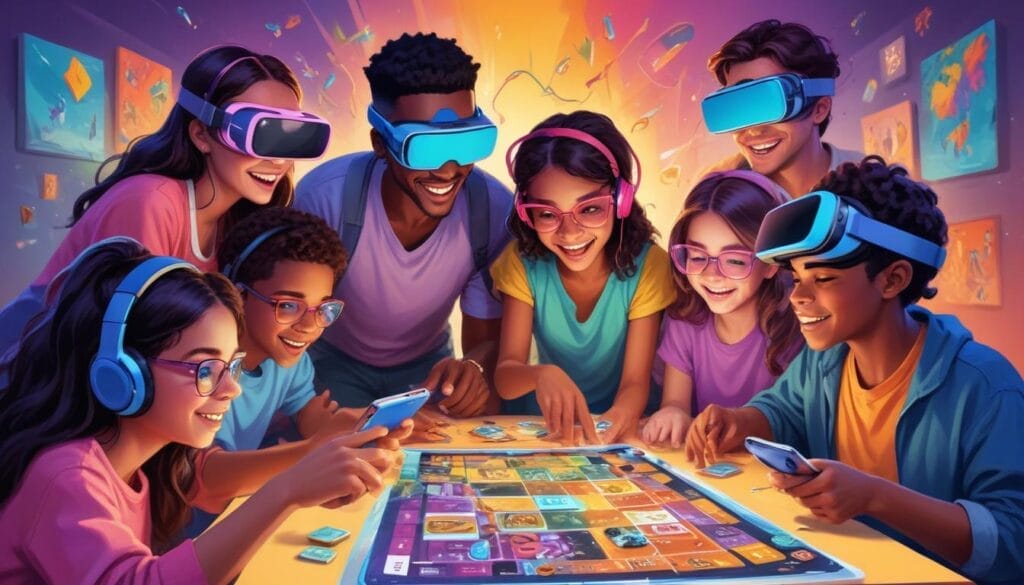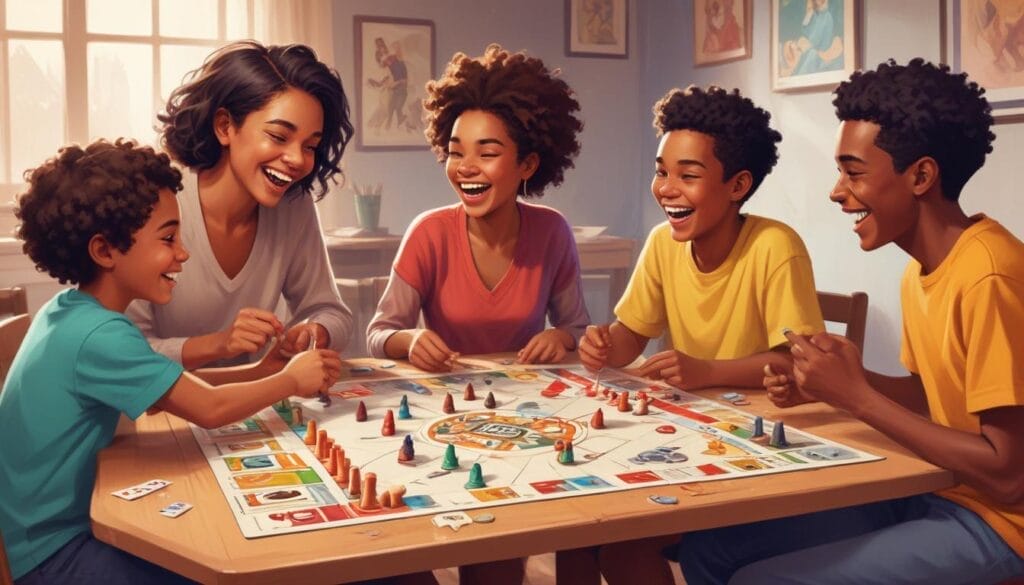A Guide to Crafting Engaging Play Experiences Tailored Across the Lifespan
Welcome to the exciting world of game creation! Have you ever wondered why some games captivate preschoolers while others challenge seasoned adults? The secret lies in understanding the unique needs and abilities of players across the lifespan. This guide delves into the essential principles and strategies behind Designing Games for Different Age Groups, helping you craft experiences that resonate entertain and engage players no matter their age. Let’s explore how tailoring gameplay visuals and challenges can unlock fun for everyone.
Key Takeaways ✨
- Know Your Player: Understanding their preferences can improve the overall UX. Effective game design hinges on understanding the cognitive emotional and social development stages of your target audience.
- Complexity Matters: Match game mechanics and rules complexity to the cognitive abilities and expectations of each age group from simple intuitive controls for preschoolers to deep strategic challenges for adults.
- Engagement is Key: Align themes narratives rewards and social features with the specific interests motivations and social needs of preschoolers children teens adults and seniors.
- Test Test Test!: Always playtest with actual users from your target demographic refine difficulty balance and ensure content is safe appropriate and inclusive.
- Balance Simplicity & Depth: Start with a clear core mechanic gradually introduce complexity through interaction and offer layers of engagement for both casual and dedicated players.
Why Age Matters in Game Design 🤔
Designing a game isn’t a one-size-fits-all process. What delights a preschooler might bore a teenager and what challenges an adult could completely overwhelm a young child. Creating truly engaging games requires a deep dive into how different age groups think feel and interact with the world and with each other. It’s about understanding developmental milestones but also grasping the unique preferences that drive fun for each demographic. This structured overview unpacks crucial considerations helping designers tailor experiences effectively.
Core Principles: The Foundation of Age-Appropriate Design
Before diving into specific age brackets certain foundational principles guide effective game design for any audience.
Matching Cognitive Capabilities
A game must align with the thinking power of its players. For younger children this means simple rules clear goals and intuitive controls. As players mature they can handle more complex mechanics strategic thinking and problem-solving demands. The goal is a challenge that feels achievable not frustratingly impossible. Cognitive load or how much mental effort a game requires should be carefully managed especially for younger players using visuals and interaction over dense text.
Tuning into Emotional and Social Needs
Games evoke emotions and facilitate social connections. Consider the emotional maturity level. Younger children might need support managing frustration or excitement within a game while adults may seek complex narratives exploring mature themes. Social interaction also varies. Some prefer cooperative play others thrive on competition. Designing appropriate social features is key whether its simple turn-taking for kids or complex online communities for adults.
What Sparks Joy? Interests and Motivations
What makes a player feel connected to the game concept? want to keep playing? Aligning themes rewards challenges and stories with what genuinely excites a specific age group is critical. Fantasy and animals might capture a child’s imagination while teens often gravitate towards relatable characters engaging storylines or innovative tech like AR/VR. Adults might seek realism depth strategic mastery or immersive worlds. Understanding these motivators fuels engagement.
Accessibility Inclusivity and Sensitivity Always
Games should welcome everyone. This means designing for accessibility considering players with different abilities. An inclusive games guide can offer insights. It also means practicing game elements that foster engagement. cultural sensitivity avoiding harmful stereotypes and ensuring content is respectful and appropriate for the intended audience globally. Adhering to content rating standards is also essential for safety.
Image Prompt: A diverse group of people (child teen adult senior) each happily interacting with a different type of game interface (tablet console board game VR headset) representing tailored experiences. Style: Colorful illustration.

Tailoring the Experience: Strategies Across Age Groups
Let’s break down specific strategies based on common age groupings understanding that these are guidelines not rigid boxes. Some excellent general game design principles apply broadly too.
Preschoolers (Ages 3-6) – Simple Fun Bright Worlds
- Design Focus: Simplicity immediate feedback sensory engagement.
- Strategies:
- Simple Rules: Keep instructions minimal and game mechanics very straightforward. Think basic matching cause-and-effect or sequence tasks.
- Bright Visuals Engaging Sounds: Use vibrant colors appealing characters and clear fun audio cues. Sensory feedback is paramount. This approach is key when designing kids games.
- Short Play Sessions: Attention spans are short cater to this with brief satisfying game loops.
- Educational Elements: Subtly incorporate learning like colors shapes numbers or letters. Many resources offer ideas for age appropriate games.
- Intuitive Controls: Use large buttons touch gestures or simple physical actions. Avoid complex inputs. Childtopia offers tips that can adapt to digital contexts too.
Children (Ages 7-12) – Growing Skills Social Play
- Design Focus: Developing skills social interaction age-appropriate challenge.
- Strategies:
- Slightly More Complex Rules: Introduce multi-step tasks simple strategy and clearer win/loss conditions.
- Age-Appropriate Challenges: Puzzles dexterity tests reaction time challenges – geared towards their developing abilities. This supports cognitive performance improvements seen with video gaming.
- Interactive Social Play: Incorporate turn-taking simple cooperation or light competition. Parallel play or playing alongside others is also important developmentally. Find ways to promote positive social skills through games.
- Skill Development: Games can enhance hand-eye coordination problem-solving reading and reaction times.
- Fun Relatable Stories: Use humor adventure mystery and characters children can connect with.
Teens (Ages 13-17) – Challenge Connection Identity
- Design Focus: Mastery social connection self-expression relevance.
- Strategies:
- Challenging Gameplay Progressive Difficulty: Teens often seek mastery. Offer deep systems skill-based challenges and a satisfying difficulty curve.
- Engaging Storylines Relatable Characters: Explore themes relevant to adolescence identity friendship challenges social dynamics.
- Social/Multiplayer Features: Online play leaderboards guilds chat and team-based activities are highly valued. Video games are social spaces for many teens.
- Innovative Mechanics: Teens are often early adopters interested in new technologies like AR/VR or unique gameplay twists. Explore trends by looking at discussions about gaming culture in different generations.
- Regular Updates: Keep the experience fresh with new content events challenges or features.
Adults (Ages 18+) – Depth Immersion Meaning
- Design Focus: Complexity strategic depth mature themes autonomy.
- Strategies:
- Mature Themes Complex Narratives: Adults often appreciate nuanced stories sophisticated humor exploration of complex ethical or social issues. However defining “mature” requires careful design consideration for diverse audiences.
- Realistic Graphics Immersive Worlds: High production values detailed environments and believable aesthetics enhance immersion.
- Deep Multilayered Mechanics: Offer systems that players can explore optimize and master over long periods. Balancing this complexity is a key challenge.
- Strategic Skill-Based Challenges: Provide opportunities for deep thinking planning precise execution and rewarding skillful play.
- Diverse Inclusive Characters: Representation matters in game design for children. Offer a wide range of characters that players can identify with or find interesting to enhance their game play experience.
Seniors (Ages 56+) – Accessibility Comfort Connection
- Design Focus: Cognitive engagement social connection ease of use comfort. General guides on designing board games for all ages often contain applicable principles.
- Strategies:
- Simple Interfaces: Ensure clear navigation large fonts high contrast visuals and intuitive controls. Check resources like Gammaux on designing for different age groups for tips.
- Adjustable Difficulty: Allow players to tailor the challenge level to their preference and ability.
- Cognitive Stimulation: Puzzles memory games strategy games or brain teasers can provide enjoyable mental exercise.
- Social Cooperative Play: Games that facilitate connection with family friends or peers are often highly valued.
- Clear Visuals Audio Cues: Ensure text is legible sound is clear and important information is easily perceived.

Game Design Features Compared: A Snapshot 📊
This table summarizes how key features might differ across age groups based on the principles discussed:
| Feature | Kids (3–12) | Teens (13–17) are an important demographic when designing game elements. | Adults (18+) |
|---|---|---|---|
| Rules | Simple clear | Moderate complexity | Complex strategic |
| Visuals | Bright colorful | Trendy dynamic | Realistic detailed |
| Story | Light whimsical | Relatable dramatic | Mature nuanced |
| Social Interaction | Cooperative basic | Competitive online | Cooperative/competitive |
| Challenge Level | Low to moderate | Moderate to high | High skill-based |
(Source: Adapted from provided document data)
Digging Deeper: Cognitive & Emotional Factors in Children’s Games
Understanding how children think and feel is paramount when designing for them, especially in the context of game play. It’s not just about simplification it’s about aligning with their developmental journey.
Cognitive Considerations🧠
- Skill Appropriateness: Games must match what kids can actually do mentally. Younger kids need visual cues simple rules. Older kids can tackle more complex problem-solving memory tasks. Some studies suggest video gaming may boost cognitive performance. Puzzle and memory games seem particularly good for building these skills. Consider the general impact of video games on cognitive development.
- Cognitive Load: Don’t overwhelm them! Use images audio interaction rather than lots of text. Keep information digestible. Visual engagement helps according to some research on game-based learning.
- Motivation & Rewards: Challenge needs balance with ability. Tangible rewards points badges keep kids motivated persistent supporting cognitive growth. Studies like those in Frontiers in Psychology explore these links.
Emotional Considerations ❤️
- Emotional Regulation: Games offer safe spaces experience manage feelings like excitement frustration or joy. Learning to handle winning and losing is a skill.
- Self-Confidence & Resilience: Encourage trying new things taking risks. Frame failure as a chance learn build resilience. This fosters confidence.
- Empathy & Perspective-Taking: Role-playing collaborative games help kids understand others’ viewpoints practice empathy. Exploring different roles builds emotional intelligence. There’s research on how games impact children’s emotional competence.
- Engagement & Enjoyment: Fun matters! Games that spark curiosity excitement satisfaction keep kids motivated involved. Emotional engagement drives learning. Check findings on social participation through digital games.
Practical Design Implications for Kids’ Games
- Age-Appropriate Content: Challenges narratives rewards MUST fit cognitive emotional maturity.
- Visual/Audio Design: Bright visuals clear audio interactive elements support both thinking feeling. Use design effectively as explored in papers about Game environment design should prioritize usability for the target age group..
- Feedback & Scaffolding: Give immediate helpful feedback guide kids through mistakes build confidence. Don’t just say “wrong” explain why or suggest next steps.
- Social Features: Use cooperative competitive elements support teamwork communication empathy. Design activities that promote key social skills.
Quick Summary: Cognitive & Emotional Design Factors
| Factor | Cognitive Development | Emotional Development |
|---|---|---|
| Game Complexity | Age-appropriate rules/mechanics | Manageable challenge not overwhelming |
| Presentation | Visual interactive low text | Engaging emotionally resonant |
| Feedback | Immediate clear constructive | Encouraging supportive |
| Social Interaction | Collaborative problem-solving | Empathy cooperation role-play |
| Rewards | Skill-based motivating | Confidence-building resilience can be fostered through game play that challenges players appropriately. |
(Source: Adapted from provided document data)
Integrating these cognitive and emotional principles creates better more engaging games for children supporting their overall growth.
Facing the Gauntlet: Challenges in Designing for Adults ⚔️
Creating games for adults brings its own set of hurdles distinct from designing for kids.
- Balancing Complexity & Accessibility: Adults often want depth complex mechanics. But the game must still be approachable for newcomers or casual players. Finding that sweet spot is tough discussed often in game design forums. Common game design process pitfalls highlight this.
- Scope Creep & Feasibility: Big ideas are great but can spiral out of control. Designers must prioritize core features plan realistically manage resources avoid endless feature creep. Sticking to a plan is crucial even with common game development challenges.
- Sustained Engagement & Replayability: Adults expect lasting value. This means balanced mechanics meaningful choices diverse content systems rewarding long-term investment. Keeping players hooked is an art. Explore ways to overcome challenges in game design.
- Innovation vs. Familiarity: How original should a game be? Too much novelty can confuse players too little feels derivative. Striking the right balance is key. This is a frequent topic on platforms like LinkedIn discussions about game design challenges.
- Narrative & Thematic Depth: Crafting compelling mature narratives that resonate without being cliché demands skill. Storytelling for adults requires nuance.
- Game Balance & Fairness: Especially in multiplayer games ensuring all elements are balanced fair is critical. This requires rigorous playtesting iteration.
- Tool & Resource Limits: Access to tools budget or reliance on programmers can constrain design. Limited resources are a common challenge for game developers.
- Team Collaboration: Larger projects mean coordinating diverse teams maintaining a unified vision. Good communication is vital.
- Visual & Environmental Design: Creating immersive believable worlds that support gameplay narrative especially with high adult expectations is complex.
Successfully navigating these challenges requires careful planning iterative design deep audience understanding.

The Balancing Act: Complexity vs. Simplicity in Mechanics ⚖️
How do you make a game easy to learn yet deep enough to master? It’s about balancing complexity and simplicity.
- Start Simple: Begin with one clear core mechanic easy understand. This is the foundation. Simplicity is often key for better game design skills.
- Layer Complexity Gradually: Introduce new rules features over time perhaps through levels tutorials. Let players master basics first. Use rational level design challenge players just beyond current skill. How to balance complexity and simplicity is a constant question.
- Depth Through Interaction: Simple mechanics interacting can create emergent complexity without adding rules. Combining basic actions yields strategic possibilities. As noted let simple designs interact complexity appears independently. Finding this balance discussed in places like Reddit’s gamedesign forum.
- Maintain Clarity: Even with depth keep things intuitive. Use good feedback visual cues tutorials. Avoid overwhelming players. This balance is vital for mobile game design too.
- Multiple Engagement Layers: Design for different player types easy pickup hard master. Surface simplicity attracts underlying depth retains. Consider the complexity vs simplicity debate.
- Playtest Iterate: Test constantly with real players find confusion points. Use feedback refine mechanics pacing. How to balance playability and complexity often comes down to testing.
- Difficulty Options Adaptive Systems: Offer adjustable difficulty or systems that adapt player skill ensuring appropriate challenge. Advice on balancing simplicity and complexity often mentions this.
Quick Summary: Balancing Complexity & Simplicity
| Principle | Simplicity Focus | Complexity Focus |
|---|---|---|
| Core Mechanic | Easy to learn when designing a game for kids. | Hard to master |
| Introduction | Gradual tutorialized | Layered emergent interactions |
| Player Experience | Accessible clear | Deep strategic rewarding |
| Engagement | Immediate intuitive | Sustained challenging |
| Feedback | Direct visual supportive | Nuanced strategic adaptive |
(Source: Adapted from provided document data)
A well-balanced game starts simple offers layers of depth. Focus on clear core mechanics gradual complexity constant testing ensures accessibility long-term engagement. This is how you balance a game between simplicity and complexity.
Let’s Get Social: Incorporating Interaction Across Ages 🤝
Games are powerful social tools. Fostering positive interaction requires tailoring activities developmental stages needs.
Young Children (Preschool/Early Elementary)
- Cooperative Play: Simple turn-taking games like “Roll the Ball” or “Simon Says” teach patience listening sharing impulse control. These are foundational social skills activities. Many engaging games improve social skills.
- Imaginative/Parallel Play: Dress-up dolls pretend play boost creativity empathy. Playing alongside others (parallel play) helps kids learn social cues. Understanding social interaction milestones in play is useful.
- Emotion Games: “Emotion Charades” helps recognize express feelings building empathy nonverbal skills. These are great social skills activities for kids.
- Group Activities: Collaborative storytelling building projects require communication teamwork joint problem-solving. Consider tips for group games building social skills.
Older Children (Late Elementary/Middle School)
- Team/Cooperative Board Games: Games needing group strategy negotiation shared goals foster collaboration communication.
- Role-Playing/Scenario Games: Escape rooms role-playing encourage perspective-taking empathy complex social problem-solving.
- Group Challenges: Mixing teams rotating roles helps kids interact with different peers broaden social experience.
Teens and Adolescents
- Debate/Discussion Games: Structured debates promote respectful communication critical thinking perspective-taking.
- Online Multiplayer/Social Video Games: Provide spaces social experimentation teamwork community-building within safe boundaries.
- Team-Building Activities: Develop leadership negotiation conflict-resolution skills through structured challenges.
Adults
- Complex Cooperative/Competitive Games: Deep strategy board games sports online games involving alliances trading negotiation foster sophisticated social interaction.
- Social Platforms/Communities: Integrated forums chat events support ongoing interaction collaboration community.
- Role-Playing/Simulation Games: Allow exploring different social roles practicing empathy collaborative storytelling.
General Strategies for All Ages
- Model Positive Interaction: Set tone kindness respect empathy. Encourage listening turn-taking support during play.
- Facilitate Communication: Provide ways express ideas feelings strategies in-person online.
- Mix Teams/Roles: Change groupings help players interact variety peers build adaptability broaden networks.
- Integrate Social Games: Use family game nights classroom activities online events make social gaming regular enjoyable part life.
Effective social interaction comes from matching activities that promote cooperation and communication, creating supportive fun environments that practice social skills through play the game.

Conclusion: Designing for Delight Across the Lifespan 🎉
Ultimately designing games for different age groups means becoming a student of human development. It demands empathy creativity a willingness listen learn. By carefully considering the cognitive emotional social needs unique interests of each audience aligning gameplay visuals narrative mechanics accordingly designers can craft truly rewarding experiences. Remember playtest rigorously embrace feedback ensure accessibility inclusivity. The goal is create engaging inclusive fun games that resonate with players no matter their age bringing a little more joy into world.
FAQ Designing Games for Different Age Groups
What are the recommended age ranges for designing games?
A: Recommended age ranges typically include categories such as 3-5 years for toddlers, 6-12 years for children, 13-17 years for teens, and 18+ for adults. Understanding these age ranges helps in tailoring content and mechanics suitable for each group.
How should game design for children differ from adult game design?
A: Design for children often requires simpler mechanics and engaging visuals. Children under 12 have different cognitive capacities and motor skills, so games should incorporate design guidelines that promote learning and fun without overwhelming them.
What are some key design guidelines for creating games for various age groups?
A: Design guidelines include considering cognitive skills, attention spans, and motor abilities appropriate for each age range. For younger players, games should be straightforward with clear objectives, while older players can handle more complex strategies.
What role does interface design play in designing games for different age groups?
A: Interface design is crucial because it affects user experience. For younger players, interfaces should be intuitive and visually appealing, while for older gamers, they can afford to be more sophisticated but still need to ensure accessibility and clarity.
Can you provide examples of design recommendations for a card game aimed at children?
A: For a card game designed for children, recommendations include using bright colors, simple rules, and fun illustrations. The content of the game should be relatable to their experiences, and it should encourage social interaction and cognitive development.
How can gamification be effectively used in games for different age groups?
A: Gamification can be effectively used by incorporating elements like rewards, point systems, and challenges that are age-appropriate. For younger audiences, these elements should be simple and visually engaging to enhance motivation and engagement.
What are some challenges professional game designers face when creating games for various age groups?
A: Professional game designers often face challenges such as balancing complexity and engagement. They must ensure that the game is able to cater to the cognitive capacity of each age range while also being fun and educational.
Why is co-design important when creating games for children?
A: Co-design is important because it involves children in the development process, providing insights into their preferences and play styles. This collaboration helps ensure that the final product resonates with the target age group and meets their needs.
How can case studies inform the design of board games for different age groups?
A: Case studies can provide valuable insights into successful design strategies and user feedback. By analyzing how different age groups interact with existing board games, designers can identify effective mechanics and themes that resonate across various age ranges.
What skills do children often develop through well-designed games?
A: Well-designed games can help children develop new skills such as problem-solving, critical thinking, and teamwork. Games tailored for children often enhance their cognitive skills and ability to create strategies, which are essential for their growth and development.


















